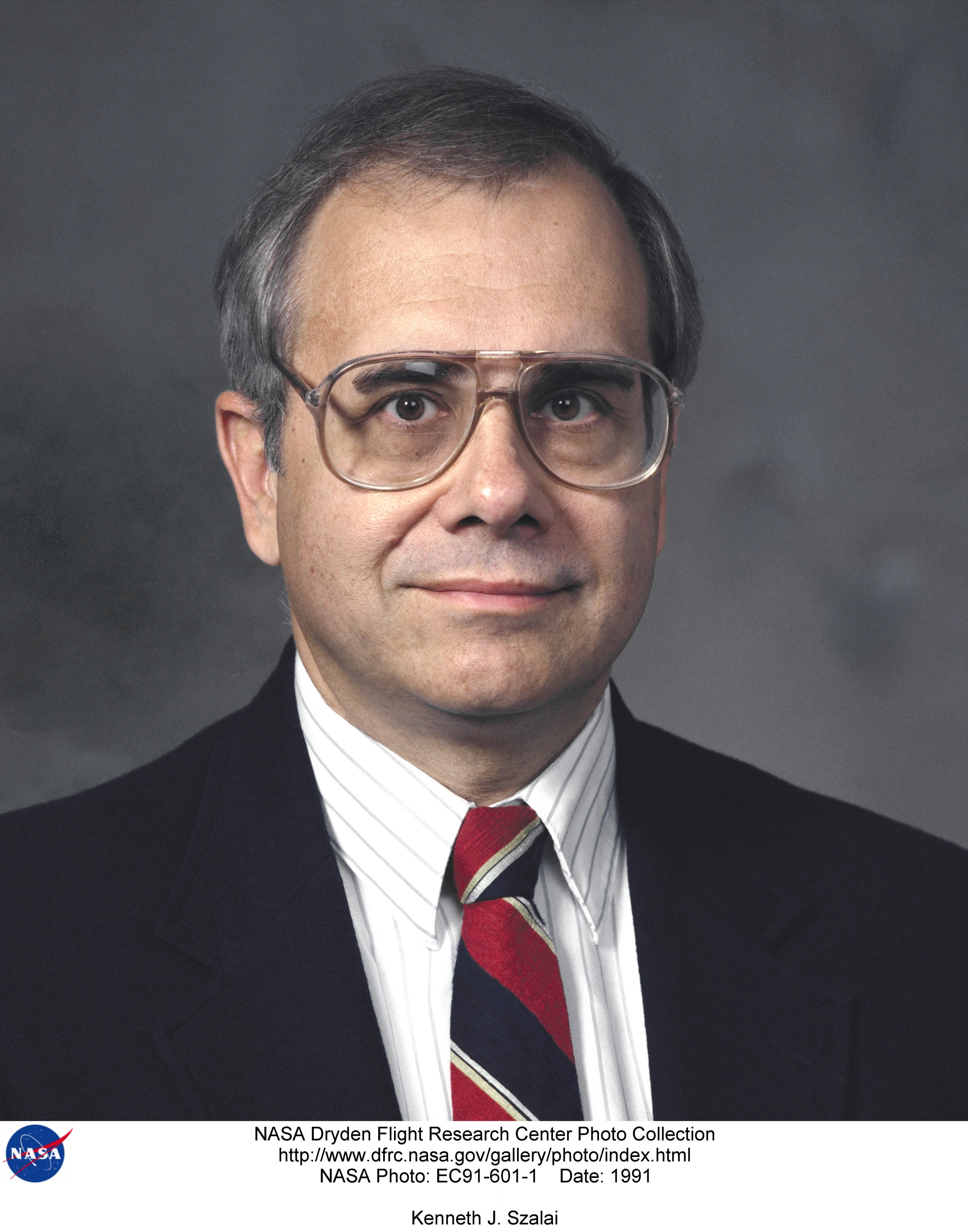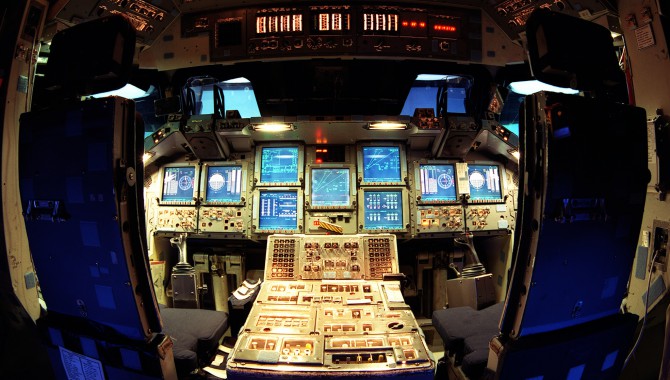
By John O’Neill
Personnel at the Mission Operations Directorate at the Johnson Space Center are the final integrators of the planning and execution steps that must occur to get from mission definition and design to flight. Over the years, the technology of some of this essential work has changed, but the general principles and the dedication and skill of those doing it remain the same. A brief look at the history of planning, training, and flying—the three related functions within human space flight mission operations—will make some of the challenges clear and show how we met them in the past and how we meet them today.
Planning
President Eisenhower once said, “It has been my experience in a really great crisis that plans were useless but that planning was indispensable.” That is a good guiding principle for the contingency planning that always goes into NASA missions, but, in the complex environment of space, rigorous planning is equally indispensable in accomplishing the defined mission objectives.
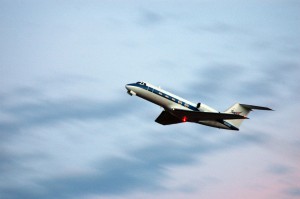
On NASA Kennedy Space Center’s Shuttle Landing Facility, the Shuttle Training Aircraft (STA) takes to the skies. The STA is a Grumman American Aviation-built Gulf Stream II jet that was modified to simulate an orbiter’s cockpit, motion and visual cues, and handling qualities. In flight, the STA duplicates the orbiter’s atmospheric descent trajectory from approximately 35,000 ft. altitude to landing on a runway. Because the orbiter is unpowered during reentry and landing, its high-speed glide must be perfectly executed the first time.
Photo Credit: NASA
Once mission requirements and spacecraft capabilities are in hand, planning essentially begins with the trajectory, navigation, and guidance design. Consider the challenges faced by the Apollo trajectory planners. Activities associated with trajectory control were the largest part of the operational overhead on every Apollo mission. In key mission phases, trajectory control took priority over all other activity and drove the timeline. The trajectory was the framework or skeleton for all subsequent plans and procedures. Before the first moon flights, engineering, trajectory, science, and operations personnel collaborated to develop Design Reference Missions to give “best estimate” guidance to the Apollo mission designers. The Gemini program and its rendezvous missions provided a key source of data that the planners needed to design accurate lunar trajectories.
The flight-planning effort also included developing and refining crew procedures. The flight plan itself was and still is a precise sequence of the interrelated crew and ground support activities. This operations documentation shapes the training that familiarizes crew and controllers with mission procedures and contingencies.
Flight crews also wanted “cue cards”—irregularly shaped cards that fit in available panel space in the crew station—to summarize critical procedures for ready reference. The Apollo 8 ascent cue cards provided an extra bit of excitement in the final launch preparations. The backup crew installed the cards during the last hours of the count so they would be in place for the prime crew. This meant placing the cards with their Velcro backing in position on the mating Velcro on the panel spaces. At that time, sticky-back Velcro was not yet available; when the cue cards were finalized, an adhesive was used to attach the specially shaped Velcro to the cards. Soon after the backup crew completed the installation, a pad technician discovered that the cards were falling like leaves. The adhesive had failed. In a panic procedure in the Operations and Checkout Building at Kennedy Space Center, the old adhesive was scraped off and fresh adhesive applied. The process took most of the night but was finished in time.
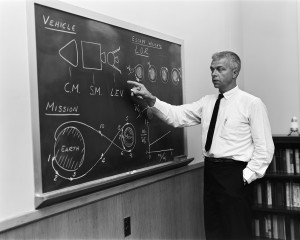
John C. Houbolt at a blackboard, showing his space rendezvous concept for lunar landings. Lunar Orbital Rendezvous was used in the Apollo program.
Photo Credit: NASA/Bob Nye
Apollo 11 obviously presented significant new challenges and produced many productive changes. Coordination between the crew and ground support was extremely critical in a mission that included lunar landing and a lunar orbit rendezvous. During the two months before flight, approximately 1,100 changes were made to the flight plan and crew checklists. All those changes were vetted by the crew, the flight controllers, and NASA and contractor engineering personnel. Doing that required streamlined and improved information exchange and led to the development of a formal configuration control process similar to that used for hardware and software today.
Consider the technology of the Apollo era for a moment. Much has been written about the limited capacity of the spacecraft and mission control computers. The lack of word processors also made the careful and accurate updating of operations documentation very tedious. And there were none of the tracking and data relay satellites to provide the full communication coverage that the Space Shuttle and International Space Station enjoy today, and no GPS for navigation support.
Those were the limits on communications resources when the entire operations and engineering force mobilized to deal with the Apollo 13 emergency. As the onboard procedures were reworked, reassembled, and modified, the extensive directions from Mission Control to the crew had to be transmitted totally over the air-to-ground voice loops. This included the famous step-by-step instructions for using tape and covers from the flight plan to adapt a command module lithium hydroxide canister for lunar module use.
Planning, reviewing, and carefully revising the plans have been the cornerstone of NASA’s mission success. Operations planning must start during the requirements phase of a program and be an integral part of the design, development, and testing phases. Two of the most important questions are, “Can the systems be operated in a normal and contingency mode that satisfies the mission requirements?” and, “Have the flight crew and ground support been given the systems intelligence and controls necessary to operate the systems?”
Training
A primary goal of intensive flight-specific training is integrating the flight crew and flight controller team. Even given the extensive experience of crews and their Mission Control Center support, the complexity and unique requirements of each flight demand intensive training. Basic training methods have not changed significantly from Apollo to shuttle, but the training tools have evolved tremendously.
Since Mercury, the core of training has been simulations that bring the crew and controllers together in as realistic a manner as possible. Normal flight phases are repeated to polish the performance and interaction of the whole team, but simulation personnel are well known for their ability to introduce problems that test documented procedures and mission rules. The simulations sometimes lead to changes and improvements, as well as to intimate knowledge of how systems operate.
An Apollo 11 example shows how important training can be to flight experience. Apollo 11 almost did not land on the moon because the crew kept receiving a series of computer alarms during the lunar module descent. But flight controllers quickly analyzed the alarms and advised the crew that they were not serious and the landing could continue. They knew that because of their training experience.

Three of the four Apollo 13 flight directors applaud the successful splashdown of the command module “Odyssey” while Dr. Robert R. Gilruth, director, Manned Spacecraft Center (MSC), and Dr. Christopher C. Kraft Jr., MSC deputy director, light up cigars (upper left). The flight directors are (from left to right) Gerald D. Griffin, Eugene F. Kranz, and Glynn S. Lunney.
Photo Credit: NASA
The training teams had discovered that some computer alarms intended only for ground testing could be triggered and give the crew and flight controllers a tough interpretation challenge. One of these internal computer alarms was triggered during an Apollo 10 simulation. In the process of determining that these alarms were not serious, the flight controllers investigated every alarm that the computer might display, and which were important.
Then the Apollo 10 flight introduced another factor. Problems in tracking the lunar module in lunar orbit after separation from the command module led to a decision to turn on the rendezvous radar in addition to the landing radar. Knowing the lunar module position relative to the command module provided the information needed, but this also effectively doubled the work the lunar module computer had to handle, especially when shifting to the higher computation cycles during Apollo 11 descent. As the machine began to be overloaded, it started shedding less important tasks and sending alarm codes at an increasing frequency. With their in-depth understanding of the alarms, the flight controllers could determine that the critical tasks were being accomplished and gave the “go ahead” to continue the landing.
The evolution in training has been driven by improvements in the supporting computer technology. Basic spacecraft systems familiarization and operations procedures instruction is workstation-based and extremely realistic. But the major steps forward in the realism of the crew training with an accurate interface to the Mission Control Center have been in the mission simulators.
For both Apollo and shuttle, mockups and part-task trainers were important components of overall crew training. The Shuttle Training Aircraft covers the orbiter approach and landing phase, but the spacecraft simulators provide the mission environment. For the Apollo command module and lunar module training, both spacecraft required simulator crew stations that could operate in concert to cover mission operations, including the lunar module’s lunar surface approach and landing. The software had to reproduce the actual flight systems with total accuracy. Because virtual image technology was not available then, the simulator out-the-window views were produced by a camera moving over a 3-D model of the lunar landing site. Based on robotic spacecraft imagery, the models were produced by the Department of Defense mapping facility in St. Louis.
The Shuttle Mission Simulator is the primary system for training shuttle crews. This high-fidelity simulator can train crews in all mission phases. There are two orbiter crew cockpits, both representative of an actual orbiter. A fixed-base crew station (FBCS), used for orbital training, accommodates the commander, pilot, mission specialist, and payload positions and has navigation, rendezvous, remote manipulator, and payload support systems so payload operations can be simulated. A motion-based crew station for ascent and entry training features a modified six-degrees-of-freedom motion system to give the commander and pilot the “feel” of mission phases. Digital image–generation systems provide window views in both simulator bases. The landing runway image and the ability to realistically project payload operations are particularly impressive.
During the simulations, system status and crew operations are transmitted to the flight controllers in the Mission Control Center just as they would be in flight. This enables the introduction of scenarios in which the crews and flight controllers must react to emergencies. The goal is to encounter no actual flight situations that have not been trained for in some manner.
Flying
Mission objectives have been finalized. The flight plan, mission rules, and operational procedures have been developed, refined, and validated in training and then refined, reviewed, and redefined to a final preflight configuration. The flight crew and the flight control team are trained, and the Mission Control Center is configured and ready. Now it is up to the great launch teams at Kennedy and to Mother Nature’s winds and weather. So it has been through the launches before and during Apollo, for intervening programs, and through shuttle.
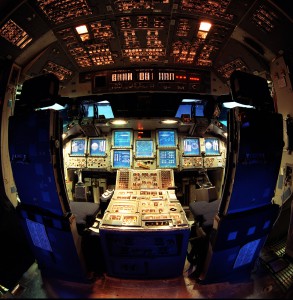
This “fish-eye” view shows NASA’s Multifunction Electronic Display Subsystem (MEDS), otherwise known as the “glass cockpit.” The fixed-base Space Shuttle mission simulator in the Johnson Space Center’s Mission Simulation and Training Facility was outfitted with MEDS to be used by flight crews for training.
Photo Credit: NASA
When the launch vehicle and spacecraft clear the pad, the Mission Control Center takes the handover from the launch team. Occasionally, the mission goes nearly exactly as planned. This has seldom been the case, but most eventualities are handled by the flight crew working with the flight controllers using established procedures, contingency and malfunction procedures refined in training, and the ingenuity of the combined team.
On what have fortunately been rare occasions, the combined team has been challenged by extraordinary issues. That is when the entire flight control team must muster its combined knowledge and experience. Contingencies have also produced individual flight controllers whose decisive actions have established them as icons in the history of human space flight.
I will name just a few. There was Steve Bales and Jack Garman’s response to the computer alarms during the Apollo 11 descent, and John Aaron’s actions after the Apollo 12 lightning strike during liftoff. They avoided an abort in both cases. There was the life-saving response of the entire control team under the leadership of Flight Directors Gene Kranz and Glynn Lunney after the Apollo 13 explosion. The shuttle program experienced two tragedies, but the overwhelming number of safe and successful missions and contributions to science and technology speak to the careful planning, training, and development of people, procedures, and teamwork in mission operations. Finally, any discussion of the contributions to NASA’s programs by operations must recognize the leadership, vision, and operations capability of Chris Kraft, the original flight director and the example to all who have followed.







